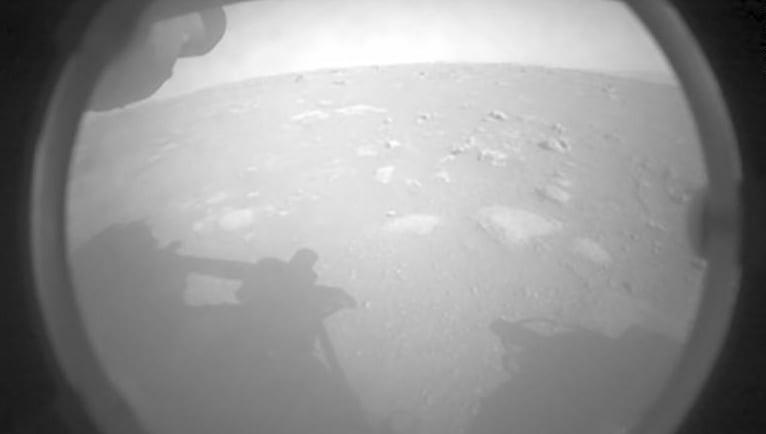
The NASA rover, which successfully landed on Mars on Thursday, sent over its first grainy pictures of the “red” planet directly after touchdown, to the jubilation of all the scientists at Mission Control.
The craft called “Perseverance” landed in a deep crater near the planet’s equator called Jezero.
“The good news is the spacecraft, I think, is in great shape,” said Matt Wallace, the mission’s deputy project manager.
Engineers at NASA’s Mission Control in California erupted with joy when the confirmation of touchdown came through.
Applause continued as the first two photographs came in.
They were taken by low-resolution engineering cameras.
There was dust covering the still-attached translucent lens covers, but it was possible to see a flat surface both in front and behind the rover.
Hello, world. My first look at my forever home. #CountdownToMars pic.twitter.com/dkM9jE9I6X
— NASA's Perseverance Mars Rover (@NASAPersevere) February 18, 2021
Looking for life on Mars
The six-wheeled vehicle will now spend at least the next two years drilling into the local rocks, looking for evidence of past life.
Jezero is thought to have held a giant lake billions of years ago. And where there’s been water, there’s the possibility there might also have been life.
Its primary aim is to search for possible fossilized signs of microbes that may have flourished on Mars about 3 billion years ago, when the fourth planet from the sun was warmer, wetter and potentially hospitable to life.
Post-landing analysis indicated the vehicle had come down about 2 km (1.2 miles) to the southeast of the delta feature in Jezero that Perseverance plans to investigate.
“We are in a nice flat spot. The vehicle is only tilted by about 1.2 degrees,” said Allen Chen, who led the landing team.
“So we did successfully find that ‘parking lot’ and have a safe rover on the ground. And I couldn’t be more proud of my team for doing that.”
Landing was the riskiest part
Perseverance approached Mars at around 12,400 miles per hour, although when it hit the top of the Martian atmosphere, a heat shield slowed it down to about a tenth of this speed.
Then a supersonic parachute popped out of the rover to reduce its speed to a few hundred miles per hour.
At that point, descending under the parachute, Perseverance was still travelling far too fast to land safely.
So it cut itself loose from the parachute and used rocket thrusters to slow down further.
The thrusters allowed it to hover roughly 20 meters above the surface, before the rover was lowered by cables to the surface using a rocket platform called a sky crane.
The landing represented the riskiest part of two-year, $2.7 billion endeavor.
Miss my landing? Catch the highlights below.
Send us your own highlights too. Share your pictures and video using #CountdownToMars. pic.twitter.com/OL2wSAi36e
— NASA's Perseverance Mars Rover (@NASAPersevere) February 19, 2021
President Biden congratulated NASA for its great achievement.
He noted that the successful landing proves “that with the power of science and American ingenuity, nothing is beyond the realm of possibility.”
Related: Greek Scientist Invents System to Produce Oxygen on Mars
See all the latest news from Greece and the world at Greekreporter.com. Contact our newsroom to report an update or send your story, photos and videos. Follow GR on Google News and subscribe here to our daily email!



